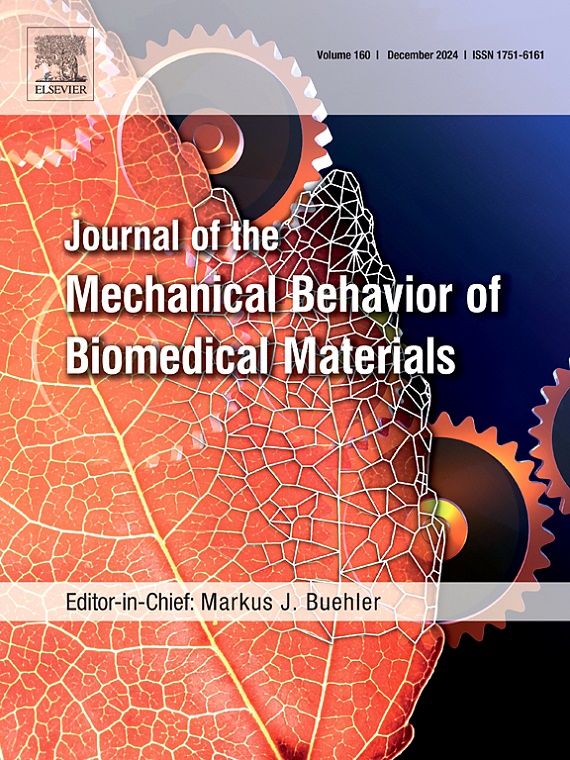心力衰竭左心室扩张器优化设计及耐久性测试的计算机方法
IF 3.5
2区 医学
Q2 ENGINEERING, BIOMEDICAL
Journal of the Mechanical Behavior of Biomedical Materials
Pub Date : 2025-07-11
DOI:10.1016/j.jmbbm.2025.107134
引用次数: 0
摘要
左心室(LV)扩张器是弹簧状装置,专门用于治疗具有保留射血分数(HFpEF)的心力衰竭。它们的目的是在心脏放松时机械地促进心室外扩张,从而增强左室充盈。本研究展示了如何使用硅模型来探索设备功能,以改善心脏性能并优化其设计。不同形状、大小和材料的左室扩张器植入肥大和心脏硬化的人类心脏模型,该模型是根据活体心脏项目修改的。通过生理参数量化设备对心功能的影响,并对优化设计进行疲劳分析,以评估设备的长期耐用性。所有的设计都显示出对心脏功能的积极影响。结果还表明,钴铬合金比镍钛合金更适合这种类型的应用。对优化配置的疲劳分析表明,该设备能够承受硬化合金的至少2.5年,并有可能持续使用10年。本研究表明,在HFpEF和其他心脏硬化疾病中,应谨慎使用左室扩张器。有趣的是,即使是寿命缩短的设备也可能为严重心脏僵硬的患者提供显著的好处,这些患者通常预期寿命较短。需要进一步的患者特异性分析来检查设备在临床需要的背景下,也可以用来定制和优化每个病理扩张装置。本文章由计算机程序翻译,如有差异,请以英文原文为准。
In silico methods for enhanced design optimization and durability testing of left ventricular expanders in heart failure
Left ventricular (LV) expanders are spring-like devices that are specifically dedicated to the treatment of heart failure with preserved ejection fraction (HFpEF). They are intended to mechanically facilitate outward ventricular expansion during cardiac relaxation, thus enhancing the LV filling. This study demonstrates how in-silico models can be used to explore device capabilities to improve cardiac performance and optimize their design. Various configurations of shape, size, and material of an LV expander device implanted in a human heart model with hypertrophy and cardiac stiffening that was modified from the living heart project. The devices’ effects on cardiac function were quantified by physiological parameters, and fatigue analyses were performed on the optimal design to assess the long-term device durability. All designs showed a positive impact on the heart function. The results also revealed that cobalt-chromium alloy is more appropriate than nickel-titanium for this type of application. The fatigue analysis of the optimized configuration revealed that the device is capable of withstanding at least 2.5 years with hardened alloy, with the potential to last for 10 years. This study demonstrates that the use of LV expanders may be used with caution in HFpEF and other diseases of cardiac stiffening. Interestingly, even devices with reduced longevity may still offer significant benefits to patients with severe cardiac stiffening, who typically have a shorter life expectancy. Further patient-specific analysis is needed to check the device in the context of clinical needs and can also be utilized to tailor and optimize the expander device for each pathology.
求助全文
通过发布文献求助,成功后即可免费获取论文全文。
去求助
来源期刊

Journal of the Mechanical Behavior of Biomedical Materials
工程技术-材料科学:生物材料
CiteScore
7.20
自引率
7.70%
发文量
505
审稿时长
46 days
期刊介绍:
The Journal of the Mechanical Behavior of Biomedical Materials is concerned with the mechanical deformation, damage and failure under applied forces, of biological material (at the tissue, cellular and molecular levels) and of biomaterials, i.e. those materials which are designed to mimic or replace biological materials.
The primary focus of the journal is the synthesis of materials science, biology, and medical and dental science. Reports of fundamental scientific investigations are welcome, as are articles concerned with the practical application of materials in medical devices. Both experimental and theoretical work is of interest; theoretical papers will normally include comparison of predictions with experimental data, though we recognize that this may not always be appropriate. The journal also publishes technical notes concerned with emerging experimental or theoretical techniques, letters to the editor and, by invitation, review articles and papers describing existing techniques for the benefit of an interdisciplinary readership.
 求助内容:
求助内容: 应助结果提醒方式:
应助结果提醒方式:


